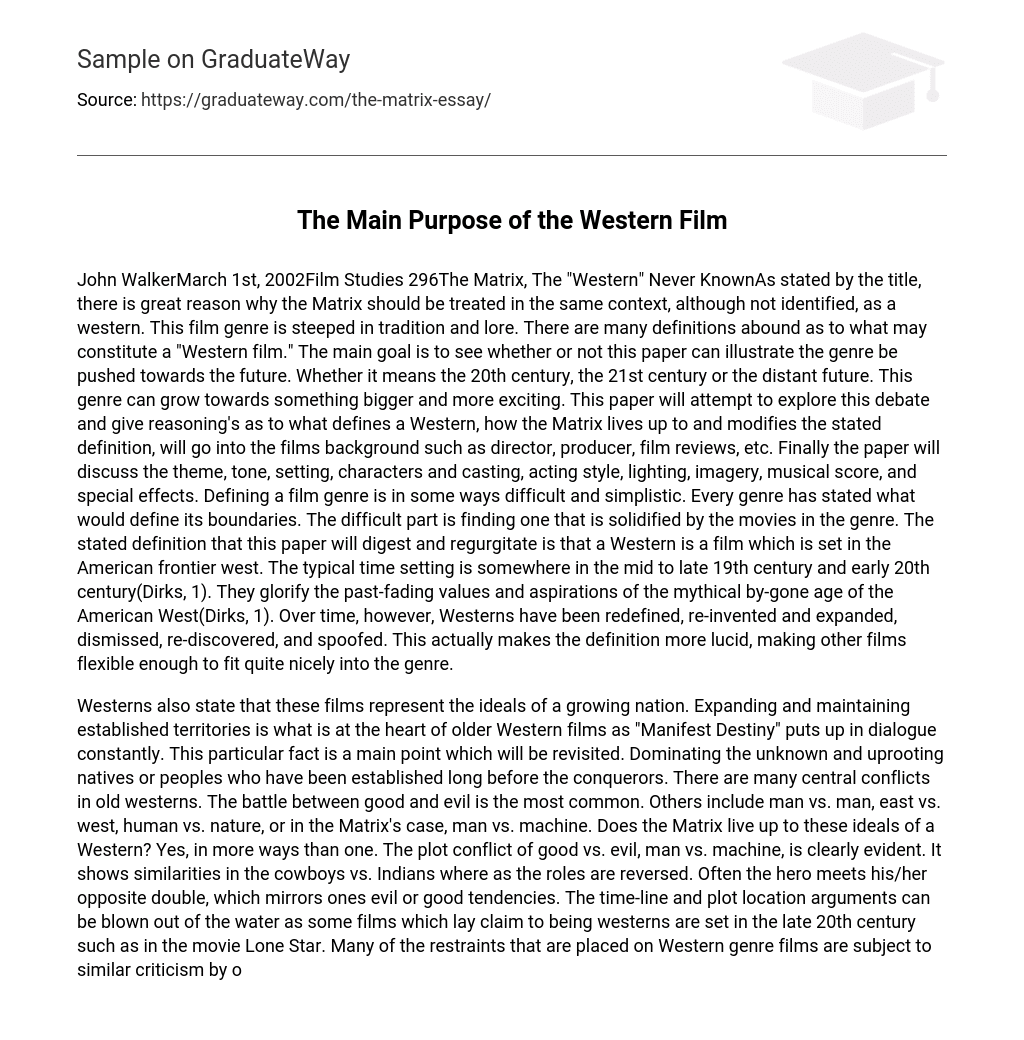Although not explicitly labeled as one, The Matrix should be acknowledged as a western due to its rich history and various interpretations. This paper aims to investigate the genre’s ability to evolve and flourish in different time periods, including the 20th century, 21st century, or even the distant future. The potential for immense growth and excitement within this genre is remarkable.
This paper will aim to examine the debate surrounding what constitutes a Western, how the Matrix aligns with and alters this definition, and delve into various aspects of the film such as its background (director, producer, film reviews, etc.). Furthermore, the paper will analyze the theme, tone, setting, characters and casting, acting style, lighting, imagery, musical score, and special effects. Genre classification in film can be both challenging and straightforward, as each genre establishes its own set of defining elements.
The challenging aspect is locating a Western movie that truly embodies the genre. The specific definition that will be discussed in this paper is that a Western is a film set in the American frontier west. Usually, the time period is during the mid to late 19th century and early 20th century (Dirks, 1). These movies romanticize the disappearing values and aspirations of the mythical era of the American West (Dirks, 1). However, as time has gone on, Westerns have been redefined, reinvented, expanded upon, dismissed, rediscovered, and even parodied. This actually strengthens the definition, allowing other films to effortlessly fit into this genre.
Old Western films are also said to portray the values of a developing country. The central theme of these movies revolves around expanding and preserving already established territories, constantly highlighting the concept of “Manifest Destiny.” This key aspect will be emphasized again. The films focus on conquering the unfamiliar and displacing indigenous or long-standing populations. Numerous significant conflicts emerge in these classic Western movies.
The most common battle is between good and evil, but there are others such as man vs. man, east vs. west, human vs. nature, or in the case of the Matrix, man vs. machine. The Matrix does live up to these Western ideals in multiple ways. The conflict between good and evil, specifically between man and machine, is clearly shown in the plot. It also resembles the cowboys vs. Indians narrative, but with reversed roles. It is common for the hero to encounter his/her opposite, reflecting their own tendencies towards good or evil.
The notion of time-line and plot location in Western films can be challenged by some movies like Lone Star, set in the late 20th century. Similar critiques can be applied to other Western genre films, like Walker, which feature modern elements like helicopters, Mercedes Benz vehicles, and Newsweek magazines. This level of incorporating different elements is also apparent in films such as the Matrix.
The Cowboys vs. Indians/man vs. machine conflict is a fascinating event that may be challenging to perceive, but once clarified, it is easier to recognize. This conflict is portrayed as Indians vs. Cowboys, as opposed to the usual perception. The cowboy archetype is typically depicted as the protagonist striving to combat the “cruel and uncivilized” Indians and remove them from the American frontier.
The Matrix and American history both exhibit a comparable pattern: the eradication of one group and the dominance of another. In the Matrix, it is the machines who have taken control, eliminating humans. Likewise, in American history, the original settlers multiplied and systematically wiped out the indigenous population through genocide. These parallels underscore the seamless linkage between these conflicts.
When the tables are turned like this, there is an almost palpable identification with the humans (Indians) and a desire for their survival and avoidance of defeat by the machines (cowboys). The presence of gunfights, final standoffs, and riding into the sunset in both scenarios further highlights the striking similarities. In the Matrix, gun battles are abundant and the last standoff between Neo (Keanu Reeves) and Agent Smith (Hugo Weaving) mirrors those witnessed in Tombstone and Unforgiven. Similarly, the film’s ending, where Neo soars into the sequel, echoes the iconic John Wayne movies where he rides off into the sunset. These explanations provide significant evidence to support the notion that the definition of “Western” allows for room for modification or, as depicted in the Matrix, “evolution”.
Directors Andy and Larry Wachowski, who also wrote the original screenplay for the Matrix, drew inspiration from Japanese Anime comic books to bring the fictional world of these comics to life. They incorporated camera angles that closely resemble those found in comic books, vividly showcasing the brothers’ boundless imagination. The film showcases groundbreaking special effects, such as the visually stunning bullet-time cinematography and intense fight scenes. Cinematography duties were handled by Bill Pope. Keanu Reeves portrays Neo, a former computer hacker who finds himself thrust into a massive revolution in a post-apocalyptic setting.
Laurence Fishburne portrays Morpheus, the leader of a rebel group operating hovercraft ships in resistance against the machines ruling over Earth. The production of certain scenes varied in duration, ranging from 2 to 16 months. Filming took place in Australia during the summer months. Visually, the entire movie is filmed with a green contrast that symbolizes the dominance of evil forces. This film is excellently executed and captivated me from beginning to end. I am genuinely a fan of the Wachowski brothers, whose exceptional writing contributed to its success.





